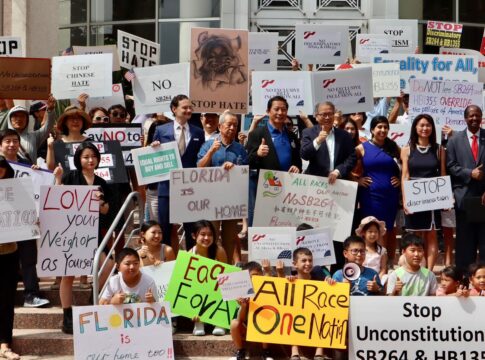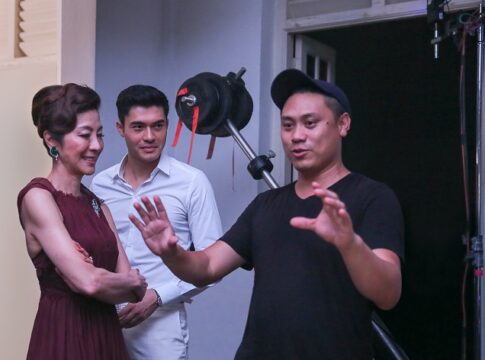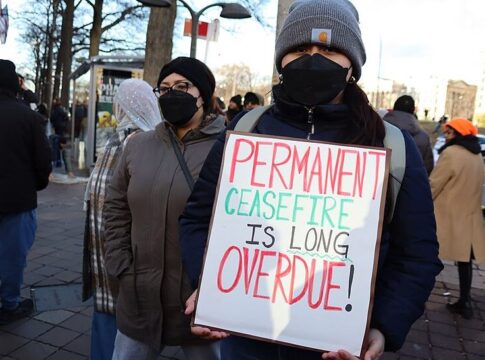By Greg Soone, Special to AsAmNews
The recently published work of Blacks living in the American south by acclaimed Chinese American photographer Baldwin Lee brings to mind another Chinese American photographer. A decade earlier Chris Huie, who hails from the deep South, had photographed African Americans in his Arkansas neighborhood.
Chris was a part of the pioneering Asian American art collective Kearny Street Workshop (KSW) founded in 1972 and located on the edge of San Francisco Chinatown. Among KSW’s multi-talented artists were Jim Dong, Leland Wong, and Nancy Hom. KSW played a leading role in the nine-year struggle to preserve the city’s International Hotel and maintain low cost housing. In the early hours of August 4, 1977, Chris and other KSW photographers including Bob Hsiang were at the I-Hotel to document its eviction by mounted troopers on horses and police in riot gear. It was a violent affair with protesters being clubbed indiscriminately. These photographers bravely captured the melee at its bloodiest.

Chris also contributed heavily to KSW’s Angel Island Exhibit about the former immigration station located in the San Francisco Bay, where mostly Chinese immigrants were incarcerated upon their arrival in America. He worked closely with writer Genny Lim and historian Judy Yung who chronicled Angel Island’s deep and troubled history.
When I met Chris in the 1970s, he stood out from the other Asian American activists I knew back then. You could tell from his protruding belly that he enjoyed a good meal, but there was something else about his accent I couldn’t quite place. He had this kind of “aw shucks” demeanor that drew people in, that and his robust laugh which invited you to join with him.
LATEST STORIES
Crystal K. D. Huie was born in 1941 to Chinese immigrant parents who left Guangdong province in southern China to settle in North Little Rock, Arkansas. They owned a small grocery store in an African American neighborhood, the George D.D. Huie grocery store, that is listed on the National Register of Historic Places. Chris adjusted to being the only Chinese in town. As he told PBS, “My birth certificate said, ‘White’, which was crossed out and marked ‘Chinese.’ I grew up amidst segregation, meaning Blacks ate in the kitchen, Whites up front… And when I’d go to the movies with my Black friend Otis, I would sit downstairs, but Otis would have to go to the balcony. I remember at school, people would never ask me, Are you Chinese? They’d always say, What are you? And I’d say, I’m Navajo Indian…(dummy).” That was vintage Chris.
He faced another adjustment after leaving home. As he related, “there’s still a lot of the South in me. I find myself saying, ‘You stop funning now.’ Or ‘Dawggg, why did you do that!’ And when folks come to visit, I always offer them something to eat or drink. When I went north, one of the first things I noticed was that people didn’t offer me a damned thing.”
It was easy to take Chris lightly, as he never seemed to take himself seriously. In fact, in addition to serving in the US Army, Chris had a lengthy academic resume starting with Little Rock University in the 1960s before graduating from one of the country’s most renowned schools of photography, the Rochester Institute of Technology. He then went on to receive a masters degree in history from New York University. His many accolades include a National Endowment for the Arts Fellowship in photography, a Martin Luther King, Jr. fellowship in history, a Rockefeller Fellow in Museum Education and Community Studies, and a California Arts Council Artist in Residence. That background served him well teaching photography classes for KSW and the San Francisco Recreation and Parks (Harvey Milk) Photo Center.
Sandra Taylor-Smith, director of North Little Rock History Commission, said “the Dark Hollow neighborhood has been nationally recognized through photography by Crystal Huie, a Chinese American who lived in the neighborhood with his family in the 1970s. He started taking pictures of people in the neighborhood and 23 of his pictures are in the Smithsonian Institute.”
His photos of African Americans are beautifully showcased in his 1972 book Dark Hollow, so named for the lack of electricity in the impoverished neighborhood. It’s clear from his photographs that Chris had a very close connection with his African American neighbors, the kind of bond that says “you’re one of us.” This allowed him to shoot freely with no inhibitions, a luxury few photographers can ever take for granted. The large format, 4 x 5 photos capture the rich detail of everyday life, yet leave plenty of room to tell the full story. In the intervening years, the photos have lost none of their descriptive powers at a time when Black people in the rural South still face significant challenges.

During a stint living in New York City, Chris began taking pictures in Chinatown. This was a revelation for the North Little Rock native. He wrote that “it was the first time I had ever witnessed the Chinese New Year tradition of lion dancing and other celebrations in full dress. I was awed and moved by the spirit of the event and the excitement of the people…I realized how vital our traditions are in preserving our identity as a people and culture within the larger society of America.”
The Dark Hollow and Chinatown photos somehow made their appearance at a gallery exhibition in Santa Fe, New Mexico. As the Santa Fe New Mexican newspaper reported in 1972 “Huie was traveling through Santa Fe on his way to Los Angeles. His car, a 1954 Cadillac, broke down on the old Santa Fe Trail, and he decided to put on a show here.” Leave it to Chris to turn lemons into lemonade.
In 2009, Chris was stricken by a stroke that greatly affected his speech until his recent passing in December. It was frustrating for him not to be able to express himself clearly, but he always maintained his sense of humor. The mere mention of Li Po’s bar, a popular San Francisco Chinatown haunt back in the day, never failed to bring a smile to his face. Likewise for the New Lun Ting Cafe, otherwise known as Pork Chop House to its devoted KSW followers. I always wondered how a Chinese American boy from Arkansas no less ended up with a name like Crystal. If you think about it though, it describes Chris perfectly. Someone who refracts light brilliantly, casting a dazzling prismatic rainbow that makes any space glow.
Rest in peace, dear friend.
There is a memorial blog for Chris where people can share their memories.
AsAmNews is published by the non-profit, Asian American Media Inc. Follow us on Facebook, X, Instagram, TikTok and YouTube. Please consider making a tax-deductible donation to support our efforts to produce diverse content about the AAPI communities. We are supported in part by funding provided by the State of California, administered by the California State Library in partnership with the California Department of Social Services and the California Commission on Asian and Pacific Islander American Affairs as part of the Stop the Hate program. To report a hate incident or hate crime and get support, go to CA vs Hate.









